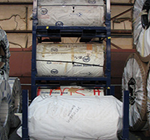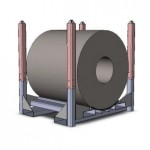What are OSHA Regulations for Stacking Pallets?
Pallets are inevitable material handling or storing equipment making their presence felt in warehouses, distribution centers, or other manufacturing facilities. Available in a wide range of configurations, they are immensely useful for the safe storage and transport of goods. Although a user-friendly and simple-to-use equipment, improper stacking of materials on pallet brings troubles and unforeseen accidents such as worker injuries, product or property damages, and so on. That is exactly why the Occupational Safety and Health Administration (OSHA) has devised a set of rules to be followed while stacking pallets. OSHA pallet stacking height must be stringently followed to assure safety when stacking pallets. Do you want to know what these regulations are? Read the post to find answers.
OSHA Regulations Pallet Stacking: A Quick Guide

Stacking pallets properly not only save space at your shop but also helps eliminate tripping and collision hazards. It also helps to categorize the goods, which in turn eases the material storage and transportation activities. But if you stack pallets carelessly or overly high, it leads to collapse, causing injuries or death to those in their vicinity. The following are the measures majorly suggested by OSHA when it comes to stacking pallets.
- Ensure that the pallets are durable enough to carry loads of any kind. Also, check the pallets for any damage before stacking the goods.
- As per the OSHA pallet stacking regulations, do not stack products with sharp corners or edges in pallets in a manner such that they face main aisles and injure any person coming near them.
- Securely tie the boxed items. You may use cross-ties or shrink plastic fiber for the purpose.
- Ensure that the metal pallets are stored in a clean place and have no protruding nails, holes, splinters, or loose boards, among others.
- Pallets must be positioned in a stable manner to avoid collapse or sliding when stacking goods on it.
- Avoid keeping stacked pallets in high traffic areas.
- Stack pallets up to 15 feet high, however, this will depend on the type of goods you stored on them.
- Do not stack products only on one side of the pallet. The load must be evenly distributed.
- If you are stacking different products, follow the practice of stacking similar items with uniform size and shape together and next to each other. Ensure to use appropriate pallets with the right capacity to stack goods.
- If there is still room for stacking items than its rated capacity, do not try to overstack the pallets.
- Always take care to stack the heaviest load at the bottom of the pallet.
- Maintain sufficient clearance around stacks. This ensures safe handling and easy access.
- Make sure to provide the workers with general ergonomics training and task-specific training to assure proper stacking.
- Do not ever stack goods in such a manner that obstructs lighting, electrical panels, or ventilation, among others.
- Climbing on the fully stacked pallets must be strictly avoided under any circumstances.
- Use protective equipment like gloves, industrial shoes, and helmets while stacking materials. You will never know when unforeseen accidents happen and cause injury to you.
- It is not advisable to stand on an empty pallet. The deck board can break or workers’ feet may get caught between deck boards.
- It is not advisable to manually lift heavily stacked pallets as per OSHA regulations, instead use a forklift or automated pallet dispenser for lifting.
Benefits of Compliance with OSHA Pallet Stacking Regulations
Enhanced Worker Safety: Compliance with OSHA pallet stacking regulations prioritizes the safety of workers. By following proper stacking procedures, organizations can reduce the risk of accidents, such as pallet collapses, falling objects, or trips and falls.
Reduced Liability and Legal Risks: By complying with pallet stacking regulations, businesses can avoid penalties, fines and potential litigation related to workplace injuries or violations. Compliance helps mitigate legal risks, protecting the organization’s reputation and financial stability.
Enhanced Productivity: Compliance with pallet stacking regulations helps create a structured and safe working environment. When employees have clear guidelines on how to properly stack pallets, they can work efficiently without the need to correct or redo improper stacking. This saves time, minimizes disruptions, and allows employees to focus on other productive tasks, leading to increased overall productivity.
Positive Workplace Culture: Prioritizing compliance with OSHA regulations fosters a positive workplace culture centered on OSHA pallet safety and employee well-being. A positive workplace culture built on safety promotes teamwork, communication and a sense of collective responsibility.
Compliance with OSHA pallet stacking regulations not only protects employees from potential hazards but also benefits organizations by reducing risks, improving operational efficiency and fostering a positive work environment. It is essential for businesses to invest in OSHA pallet safety, procedures and equipment necessary to ensure compliance and create a safe and productive workplace.
OSHA has formulated several more safety practices for stacking pallets. Following such practices, although they seem basic and simple, helps prevent damage to life and property. You may also seek tips from the manufacturer from whom you are procuring the item regarding to the OSHA safety standards. Leading manufacturers like SPS Ideal Solutions will surely guide you on tips of OSHA regulations for stacking pallets.
Related Posts:
- Tips for Rack Safety and Keeping OSHA Away
- How to Calculate Pallet Rack Load Capacity?
- Pallet Racking Vs Floor Stacking: What You Must Know?
- Why and how to Clean & Sanitize Industrial Pallet Rack?
About The Author











